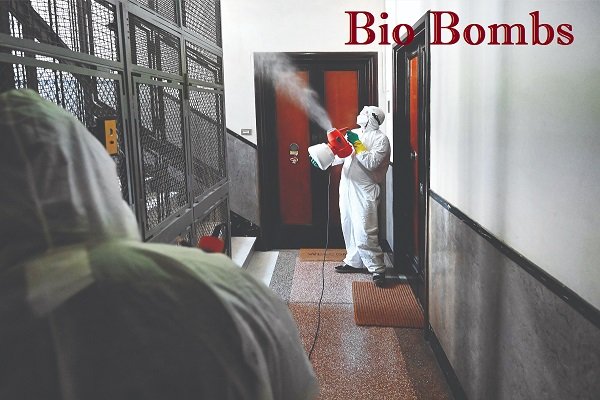Introduction
The term “bio bombs” refers to biological weapons or explosive devices designed to spread harmful biological agents. These agents may include bacteria, viruses, or toxins intended to cause mass casualties, panic, and societal disruption. Bio bombs have been a topic of concern for global security, posing threats to civilian populations and military personnel alike.
In this comprehensive guide, we will explore the definition, historical context, potential impact, safety concerns, and preventive measures related to bio bombs. Additionally, a detailed table will provide key information for quick reference.
What Are Bio Bombs?
A bio bomb is a weapon that disperses biological agents to harm or kill humans, animals, or plants. Unlike conventional bombs, bio bombs rely on infectious materials to spread disease and devastation over time rather than through immediate explosion.
Key Characteristics of Bio Bombs:
- Use of biological pathogens (bacteria, viruses, fungi, or toxins)
- Designed for delayed effects rather than immediate destruction
- May be concealed in containers like aerosol dispensers or explosive devices
- Can cause widespread panic due to contagious diseases
Historical Context of Bio Bombs
Biological warfare has a long history dating back centuries. Bio bombs are a modern evolution of this concept, designed to create mass harm through biological means.
Key Historical Events Involving Bio Bombs
| Event/Incident | Date | Details |
|---|---|---|
| Mongol Siege of Caffa | 1346 | Mongols catapulted plague-infected corpses over city walls, spreading the Black Death. |
| Japanese Biological Warfare | WWII | Japan’s Unit 731 experimented with bio weapons on prisoners of war. |
| 2001 Anthrax Attacks | 2001 | A series of anthrax-laced letters were sent to U.S. government offices, killing five people. |
Types of Biological Agents Used in Bio Bombs
Biological agents are categorized into three primary types based on their severity and transmission method.
Categories of Biological Agents
| Category | Examples | Impact |
| Category A | Anthrax, Smallpox | Highly lethal, easily transmitted, causes public panic |
| Category B | Salmonella, Ricin | Moderate impact, requires enhanced diagnostics |
| Category C | Hantavirus, Nipah virus | Emerging pathogens with potential for future weaponization |
Potential Impact of Bio Bombs
The impact of bio bombs can be catastrophic, affecting individuals, healthcare systems, and economies. Key consequences include:
1. Human Casualties:
Bio bombs can infect large populations, causing severe illness and death. Some pathogens spread rapidly, making containment difficult.
2. Economic Damage:
The aftermath of a biological attack can cripple economies due to disrupted trade, healthcare expenses, and security concerns.
3. Psychological Effects:
Fear of infection can create widespread panic, causing social unrest and mental stress.
4. Environmental Impact:
Contaminated soil, water, and air may pose long-term environmental risks.
Bio Bomb Prevention and Safety Measures
Governments and security agencies worldwide have implemented preventive strategies to minimize the risk of bio bomb attacks.
Key Prevention Strategies
| Method | Description |
| Surveillance Systems | Early detection tools for identifying biological threats. |
| Public Health Campaigns | Educating the public on symptoms and preventive steps. |
| Biosecurity Protocols | Strict handling regulations for pathogens in labs and medical facilities. |
| Emergency Response Plans | Quick mobilization plans for containment and treatment. |
How to Identify Potential Bio Bomb Threats
To recognize potential bio bomb threats, authorities use various techniques and equipment. Key indicators include:
- Unusual illness clusters
- Suspicious containers or aerosol dispensers
- Strange odors or mists in public spaces
- Reports of unexplained sickness in animal populations
Notable Bio Bomb Prevention Agencies
Several global agencies focus on bio bomb prevention and biological threat response.
| Agency | Role |
| World Health Organization (WHO) | Coordinates global biosecurity strategies. |
| Centers for Disease Control and Prevention (CDC) | Provides rapid response to biological threats. |
| Federal Emergency Management Agency (FEMA) | Develops recovery plans for bio bomb attacks. |
Key Facts About Bio Bomb
| Aspect | Details |
| Primary Threat | Biological pathogens designed to cause harm. |
| Impact | Mass casualties, economic loss, social panic. |
| Detection Tools | Biosensors, lab testing, health monitoring. |
| Preventive Steps | Public awareness, surveillance, vaccination. |
Conclusion
Bio bomb represent a significant threat to global security and public health. Understanding their mechanisms, risks, and preventive measures is crucial for ensuring safety. By educating the public and enhancing biosecurity protocols, governments can reduce the risk of bio bomb attacks and protect communities worldwide.
Read More Also: AP Bio Reference Sheet: Detailed Guide for Exam Preparation

Leave a Reply